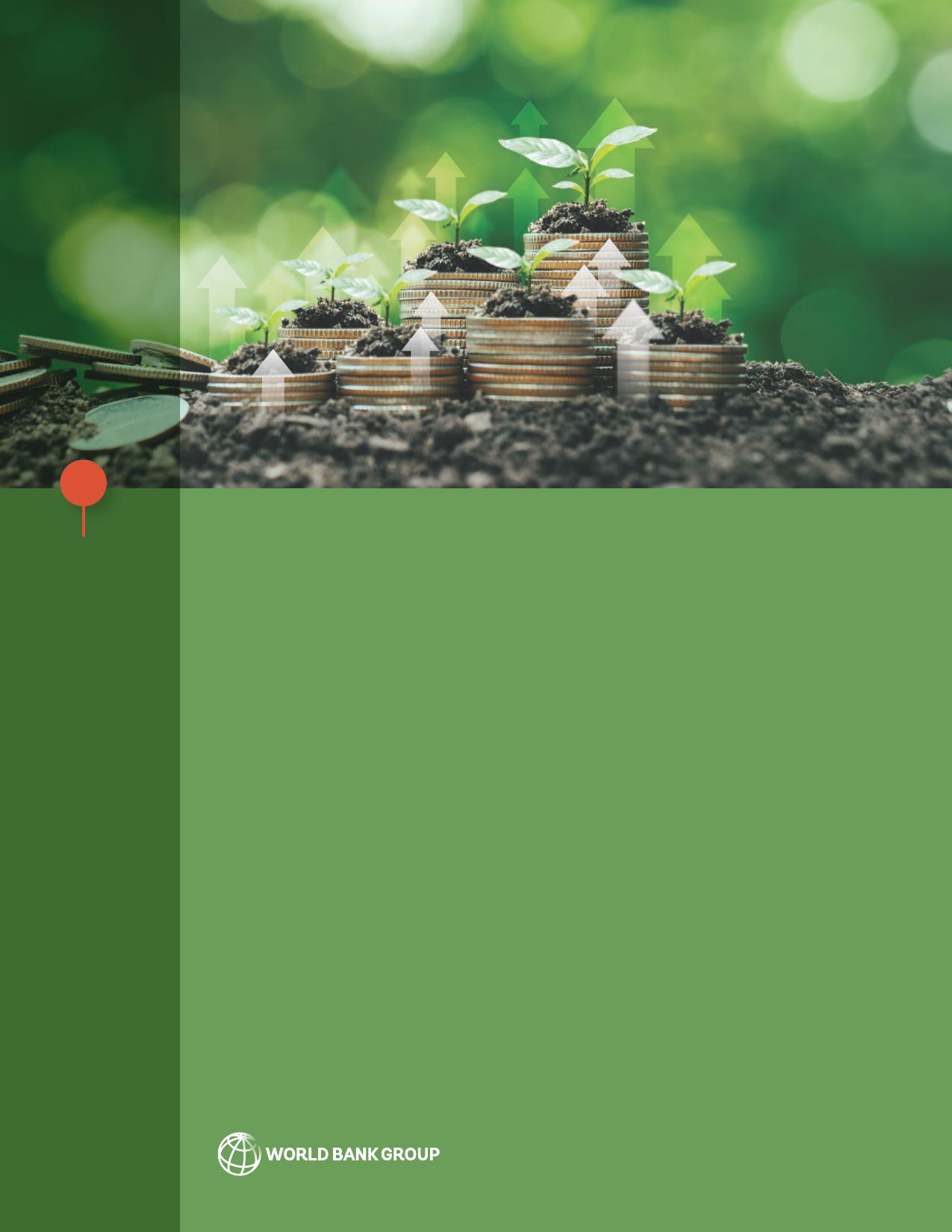INTERNATIONALDEVELOPMENTINFOCUSOVERVIEWGreeningNationalDevelopmentFinancialInstitutionsTrends,LessonsLearned,andWaysForwardEmmaDalhuijsen,EvaGutierrez,TatsianaKliatskova,RachelMok,andMartijnGertJanRegelinkOVERVIEWINTERNATIONALDEVELOPMENTINFOCUSGreeningNationalDevelopmentFinancialInstitutionsTrends,LessonsLearned,andWaysForwardEMMADALHUIJSEN,EVAGUTIERREZ,TATSIANAKLIATSKOVA,RACHELMOK,ANDMARTIJNGERTJANREGELINKThisbookletcontainstheoverviewfromGreeningNationalDevelopmentFinancialInstitutions:Trends,LessonsLearned,andWaysForward,doi:10.1596/978-1-4648-2031-1.APDFofthefinalbook,oncepublished,willbeavailableathttps://openknowledge.worldbank.org/andhttp://documents.worldbank.org/,andprintcopiescanbeorderedatwww.amazon.com.Pleaseusethefinalversionofthebookforcitation,reproduction,andadaptationpurposes.©2023InternationalBankforReconstructionandDevelopment/TheWorldBank1818HStreet,NW,Washington,DC20433Telephone:202-473-1000;Internet:www.worldbank.orgSomerightsreserved123426252423BooksinthisseriesarepublishedtocommunicatetheresultsofWorldBankresearch,analysis,andoperationalexperiencewiththeleastpossibledelay.Theextentoflanguageeditingvariesfrombooktobook.ThisworkisaproductofthestaffofTheWorldBankwithexternalcontributions.Thefindings,interpretations,andconclusionsexpressedinthisworkdonotnecessarilyreflecttheviewsofTheWorldBank,itsBoardofExecutiveDirectors,orthegovernmentstheyrepresent.TheWorldBankdoesnotguaranteetheaccuracy,completeness,orcurrencyofthedataincludedinthisworkanddoesnotassumeresponsibilityforanyerrors,omissions,ordiscrepanciesintheinformation,orliabilitywithrespecttotheuseoforfailuretousetheinformation,methods,processes,orconclusionssetforth.Theboundaries,colors,denominations,andotherinformationshownonanymapinthisworkdonotimplyanyjudgmentonthepartofTheWorldBankconcerningthelegalstatusofanyterritoryortheendorsementoracceptanceofsuchboundaries.NothinghereinshallconstituteorbeconstruedorconsideredtobealimitationuponorwaiveroftheprivilegesandimmunitiesofTheWorldBank,allofwhicharespecificallyreserved.RightsandPermissionsThisworkisavailableundertheCreativeCommonsAttribution3.0IGOlicense(CCBY3.0IGO)http://creativecommons.org/licenses/by/3.0/igo.UndertheCreativeCommonsAttributionlicense,youarefreetocopy,distribute,transmit,andadaptthiswork,includingforcommercialpurposes,underthefollowingconditions:Attribution—Pleasecitetheworkasfollows:Dalhuijsen,E.,E.Gutierrez,T.Kliatskova,R.Mok,andM.G.J.Regelink.2023.“GreeningNationalDevelopmentFinancialInstitutions:Trends,LessonsLearned,andWaysForward.”Overviewbooklet.InternationalDevelopmentinFocus.WorldBank,Washington,DC.License:CreativeCommonsAttributionCCBY3.0IGOTranslations—Ifyoucreateatranslationofthiswork,pleaseaddthefollowingdisclaimeralongwiththeattribution:ThistranslationwasnotcreatedbyTheWorldBankandshouldnotbeconsideredanofficialWorldBanktranslation.TheWorldBankshallnotbeliableforanycontentorerrorinthistranslation.Adaptations—Ifyoucreateanadaptationofthiswork,pleaseaddthefollowingdisclaimeralongwiththeattribution:ThisisanadaptationofanoriginalworkbyTheWorldBank.ViewsandopinionsexpressedintheadaptationarethesoleresponsibilityoftheauthororauthorsoftheadaptationandarenotendorsedbyTheWorldBank.Third-partycontent—TheWorldBankdoesnotnecessarilyowneachcomponentofthecontentcontainedwithinthework.TheWorldBankthereforedoesnotwarrantthattheuseofanythird-party-ownedindividualcomponentorpartcontainedintheworkwillnotinfringeontherightsofthosethirdparties.Theriskofclaimsresultingfromsuchinfringementrestssolelywithyou.Ifyouwishtore-useacomponentofthework,itisyourresponsibilitytodeterminewhetherpermissionisneededforthatre-useandtoobtainpermissionfromthecopyrightowner.Examplesofcomponentscaninclude,butarenotlimitedto,tables,figures,orimages.AllqueriesonrightsandlicensesshouldbeaddressedtoWorldBankPublications,TheWorldBankGroup,1818HStreet,NW,Washington,DC20433USA;e-mail:pubrights@worldbank.org.Coverphoto:©SakornSukkasemsakorn/iStock.Usedwithpermission;furtherpermissionrequiredforreuse.Coverdesign:DebraNaylor/NaylorDesignInc.ContentsofGreeningNationalDevelopmentFinancialInstitutionsForewordvExecutiveSummaryviiGlossaryxiiiCHAPTER1Introduction1Notes5Bibliography5CHAPTER2TheLandscapeofNDFIsNotesBibliographyCHAPTER3StateandTrendsofGreeningNDFIsGovernanceandstrategyGreenfinance:SourcesandusesClimateandenvironmentalriskmanagementClimate-relateddisclosuresandreportingNotesBibliographyCHAPTER4ToolkitsforGreeningNDFIsGovernanceandstrategyGreenfinance:SourcesandusesClimateandenvironmentalriskmanagementClimate-relateddisclosuresandreportingNotesBibliographyCHAPTER5ConclusionsandKeyRecommendationsNotesBibliographyAppendixASummaryofNDFICharacteristicsfromSurveyResponsesAppendixBNDFICaseStudiesiiiForewordGlobalpursuitofclimateandenvironmentalobjectiveswillrequiretrillionsofdollarsofinvestmentoverthenextdecade.However,manycountries,particu-larlylow-andmiddle-incomenations,aregrapplingwithsignificantfiscalandeconomicconstraintsintheaftermathofpandemic-relateddisruptionstoeco-nomicandsocialactivity.Inthiscontext,NationalDevelopmentFinancialInstitutions(NDFIs)arevitalactorsinmobilizingneededfinancingfromprivatesourcestomeetcountries’pressingneeds.Thesefinancialinstitutions,typicallystateownedanddrivenbysocioeconomicobjectives,guidecountrydevelopmentplansandpolicies.Withtheirsubstantialassets—amountingtooverUS$19trillionandaccountingformorethan10percentofglobalinvestmentsannually,NDFIshavethescaleandinfluencetoplayatransformativerole,especiallyinlow-andmiddle-incomecountries,wherepublicactorsprovide60per-centoftotalclimatefinancing,almosthalfbyNDFIs.NDFIs,whenmanagedefficiently,canhelpovercomemarketbarriersandmobilizeprivate-sectorfinancingforgreeninvestment,includingthroughtheprovisionoflong-termfinancing,aswellasinnovativestructuringofblendedfinanceandcreditenhancements.NDFIscanaddressexistingmarketgapsbyhelpingwithstructuringandco-financinglong-term,high-riskprojectsandwithsurmountingobstaclessuchasextendedpaybackperiodsandperceivedprojectrisk,particularlyforprojectsinwhichsocialreturnsexceedfinancialreturns.NDFIshavealsohelpedcreatemarketsthroughtransactiondemonstra-tioneffects,havingbeenthefirstissuersofgreenbondsinmanycountries.Thisuniquepositionmakesthemeffectiveinmobilizingfinancefrompublicandpri-vateinvestorsforprioritygoals.Likeotherfinancialinstitutions,NDFIsalsofacerisksfromclimatechangeandenvironmentalconcernsintheirinvestmentsandlending.Thus,theyareawareoftheimportanceoffollowingemergingguidanceonclimateandenvi-ronmentalriskmanagementanddisclosuresfromfinancial-sectorsupervisorsandstandardsetters.NDFIsarealsofamiliarwiththeapplicationofenviron-mentalsafeguardstolimitnegativeimpactsoftheiroperationsandcanbeaneffectiveadvocateforwiderapplicationofthesegoodpracticesthroughoutemerging-marketfinancialsystems.vviGreeningNationalDevelopmentFinancialInstitutionsTheWorldBankGroupstandsreadytosupportNDFIsthroughfundingandtechnicalassistancetostrengthentheirgovernanceandriskmanagementwhileworkingcloselywithgovernmentstocreatethepreconditionsforNDFIstocatalyzeprivatefundingforclimate.Thisreportispartofthiseffort.Itoffersacomprehensiveanalysisofthecurrenttrendsandpolicyactionsrequiredtoexpandthe“green”roleofNDFIs.Drawingonasurveyof22NDFIsfromdiverseregionsandincomelevels,aswellasin-depthcasestudiesofselectedinstitu-tions,thereportpresentsrecommendationstoenhancetheefficiency,effective-ness,andenvironmentalimpactoftheirinvestments.Italsoemphasizestheimportanceofpipelinepreparationandprivate-capitalmobilizationtoboostgreenfinance.Welookforwardtoworkingwiththesefinancialinstitutionstoapplytheles-sonsfromthisreport,expandclimateandenvironmentalinvestments,andmoveclosertothescaleofpublicandprivatefundingrequiredtoreverseclimatechange.JeanPesmeGlobalDirectorFinance,Competitiveness&InnovationGlobalPracticeWorldBankExecutiveSummaryNationalDevelopmentFinancialInstitutions(NDFIs)arecrucialformobilizingtherequiredfinancing,includingfromprivatesources,toreachcountries’cli-mateandenvironmental(C&E)objectives.Fundingneededtoachievecountries’C&Egoalsisinthetrillionsofdollars,andmanycountriesarealsofacingsignif-icantfiscalandeconomicconstraints.Low-incomeandmiddle-incomecoun-tries(LICsandMICs),otherthanChina,needanestimatedUS$783billionperyearinadditionalinvestmentsforclimateaction—torecovereducationandinvestmentlossesfromthepandemicandtoaddressconflictandfragility—through2030(WorldBank2023).NDFIshavethescaletoplayanessentialroleinmobilizingtherequiredfinancingfrompublicandprivatedonorstowardC&Egoals.NDFIsarewellpositionedtoovercomemarketbarriersassociatedwithgreeninvestmentsandcatalyzeprivate-sectorfinancing.NDFIs,whenadequatelymanaged,canaddressmarketfailuresandcreatenewmarkets.Comparedtopri-vateinvestors,NDFIshaveastrongerappetiteforfinancinglong-term,high-riskinvestmentsandcanthusovercomemarketbarriersassociatedwithgreeninvestments,suchaslongpaybackperiodsandhighperceivedprojectrisk.NDFIshavethetoolstosupportprivatecapitalmobilizationthroughde-riskinginstrumentsandblendedfinancing.Moreover,NDFIscanenableprivate-capitalmobilizationbysupportingthegenerationofagreenprojectpipelineandthroughdemonstrationtransactionsthatstimulatemarketcreation.GiventhelimitedcapacityofgovernmentstoscaleupC&Efinancingowingtocurrentfis-calconditions,NDFIs’roleinmobilizingprivatefinancingwillbecriticaltoclos-ingtheC&Efinancinggaps.Atthesametime,NDFIsmustmanagetherisksthatclimateandotherenvi-ronmentalconcernspresenttotheirinvestmentandlendingoperations.NDFIs,likeotherfinancialinstitutions(FIs),areexposedtotheimpactsofphysicalrisks—financialrisksstemmingfromtheeffectsofclimatechange,environmen-taldegradation,andlossofnatureontheeconomy—aswellastransitionrisksoriginatingfromtherealignmentofeconomieswithC&Egoals.Inaddition,lackofcompliancewithgoodC&Epracticesandregulationscanaffectthefinancialperformanceofassetsorresultinreputationalrisksfortheinstitution.Movingforward,NDFIsshouldrespondtoemergingguidancesetbyfinancial-sectorviiviiiGreeningNationalDevelopmentFinancialInstitutionssupervisorsandstandardsetterstobettermanageanddiscloseC&Erisksattheinstitutional,project,andportfoliolevels.Themainpurposeofthispublicationistotakestockofthecurrenttrendsandrecommendpolicyactionsfor“greening”NDFIs.ThereportidentifieskeystepsNDFIscantaketocatalyzefinancetowardcountries’C&Eobjectivesandman-ageC&Erisks.TheassessmentofNDFIs’C&EpracticesisbasedonareviewofkeyelementsofNDFIoperationsandtheirinstitutionalsetup.Itdrawsfromtheresultsofasurvey1conductedbytheWorldBankofgreeningpracticeswithinNDFIsbasedincountriesinarangeofregionsandincomelevels,aswellasonin-depthcasestudiesoffourNDFIs:1.LosFideicomisosInstituidosenRelaciónconlaAgricultura(FIRA,inMexico),2.KoreaDevelopmentBank(KDB,inRepublicofKorea),3.TürkiyeSinaiKalkinmaBankasi(TSKB,inTürkiye),and4.DevelopmentBankofSouthernAfrica(DBSA,inSouthAfrica).ResultsofasurveyofNDFIs(refertoFigureES.1)conductedbytheWorldBankshowthatthemajorityofNDFIshaveadoptedgreengoalsintheirstrategyandgovernanceandthatafewhavesetspecifictargetslinkedtoParisAgreementcommitments.Morethan80percentofthesurveyrespondentshavesetgreenobjectivesandpreparedstrategiestogreentheirportfolios,oftenaccommo-datedwithintheexistingdevelopmentmissionandstrategyoftheinstitution.Abouttwo-thirdsofrespondentshavemadepublicpledgesorcommitmentstoalignwithinternationalornationalclimategoals.However,onlyafewinstitu-tionshavesetspecifictargetsordisclosedtheircontributionstoC&EtargetssuchasNationallyDeterminedContributions(NDCs).ThemajorityofsurveyedNDFIshavesetgreenfinancetargetsandexcludedfinancingofsomenongreenprojects.OverhalfofthesurveyedNDFIshaveincorporatedenvironmentalandsocialconsiderationsintotheirgovernancearrangements,oftensupportedbyspecificpoliciesandstrategies,andmanyhavecreateddedicatedunitsorhigh-levelcommitteestoaddressC&Etopics.FIGUREES.1KeyresultsofNDFIsurveyNDFIsreportonC&ErisksSurveyQuestionsNDFIsassesstheimpactofC&EfinancialrisksintheirportfolioNDFIshavespecificgreenfinancingtargetsNDFIshaveC&Eobjectivesintheirmissionormandate020406080100PercentageshareofresponsesYesNoSource:Figureoriginaltothisbookandbasedonself-reportingby22NDFIs.Note:C&E=climateandenvironmental;NDFIs=NationalDevelopmentFinancialInstitutions.ExecutiveSummaryixNDFIsareleadingplayersinpublicclimatefinance,buttheshareofgreenassetsintheirportfolioremainslow,withlimitedadaptationfinancingandprivate-capitalmobilization.NDFIsprovidearound22percentoftotalglobalclimatefinancingandthemajorityofpublicclimatefinance,especiallyinLICsandMICs.2However,althoughNDFIsarecriticalplayersinpublicclimatefinancing,theshareofgreenassetsintheircreditportfoliosisstillrelativelylow,withmostsurveyrespondentsreportinggreenassetsoflessthan20percentofcreditportfolios,or14percentonaverage.Forthefewsurveyedinstitutionsthatmonitorclimateadaptationandmitigationfinance,climatefinanceisstronglybiasedtowardmitigation,mainlythroughdirectlending,withlimitedexposuretoclimateadaptation.OnlyahandfulofthesurveyedNDFIstargetandtrackthemobilizationofprivatecapital,includingthroughco-financingwithotherFIs.SurveyedNDFIsusegreenandsustainability-linkeddebtinstrumentstofundtheirgreenambitions.However,useoftheseinstrumentsremainslimited.PerceivedchallengesbyNDFIstoscalingupgreenfinancingincludeanunsup-portivepolicyenvironment,afundinggap,andlackofknowledgeandawarenessofC&Eissuesonboththeclients’andNDFIs’sides.Moreover,C&Eriskmanagementanddisclosurepracticesarestillnascent.Sofar,surveyedNDFIshavebeenintroducingC&Erisksmainlythroughthelensofenvironmentalandsocialriskmanagementsystems,assessingenvironmentalandsocialrisksattheloanoriginationlevelwithafocusontheimpactsofloansandinvestmentsonC&Efactors.Althoughthesesystemsarestillbasicinmanycases,themajorityofthesurveyedNDFIshavedevelopedsomedefinitionorclassificationsystemforgreenprojects.Atthesametime,mostNDFIsarenotassessingandmanagingexposurestoC&Efinancialrisksattheportfolioandbalancesheetlevelsorintegratingthisinformationintostrategyandgovernancearrangements.Lackofdata,standardizedmethodologies,andtechnicalcapacityarecitedascriticalchallengestomainstreamC&Eriskmanagementpractices.Moreover,whilesomeofthesurveyedNDFIshavepublicsustainabilityreports,C&Efinancialdisclosuresinlinewithinternationalguidancearemainlyabsent.NDFIscantakevariousactionstoboostgreenfinancing,includingthroughprivate-capitalmobilization,andtoimprovethemanagementanddisclosureofC&Erisks(refertofigureES.2).•NDFIsshouldintroduceinternalgovernanceandstrategyarrangementstosupporttheprioritizationofgreenobjectivesandensurestakeholdercoordination.Governancearrangementsshouldincludestrongboardinvolvementandcoordinationmechanisms.Astrategyshouldcoverthecom-pletesetofactivitiesacrossgreenfinancingandC&Eriskdimensions.Itshouldalsocommunicatecleartargets,includingthetargetedshareofgreenassets.ThestrategiescouldconsiderbroadercontextualprioritiessetoutbytheNDCsandalignwithglobalagendasaroundtheParisAgreement.NDFIsshouldalsobuildtherequiredexpertiseacrosstheorganizationbyleveraginginternationalandnationalnetworks.•Toincreasegreenfinance,pipelinepreparationandprivatecapitalmobi-lizationshouldtakecenterstage.NDFIscansupporttheenablingenviron-mentforprivatecapitalthroughthedevelopmentofbankableprojectsusingtechnicalassistance,marketeducation,standardizationofapplicationproce-dures,andthecreationofprojectpreparationfacilities.ImprovedaccesstointernationalconcessionalclimatefundscanfurthersupportNDFIstofinancetheirambitions.Wherepossible,NDFIsshouldexploreusingmorexGreeningNationalDevelopmentFinancialInstitutionsinnovativeinstruments(beyonddirectlendingactivities)tocatalyzeprivatefinance.Thisworkincludesincreasingfocusonblendedandequityfinancing,aswellasscalinguptheuseandpilotingofinnovativegreeninstruments,suchassustainability-linkedbondsandloanstoincentivizegreenperfor-mance.NFDIsshouldalsoexpandtheirofferingsincriticaldevelopmentareasthatgenerateimportantglobalordomesticpublicgoods,suchasadap-tationandnature-basedfinancing.•AbetterandmoresystemicunderstandingofC&EfinancialrisksisanimportantfirststeptoinformingC&Eriskmanagementpractices.NDFIsshouldadoptcomprehensiveC&Eriskmanagementapproachesthatcon-siderC&Erisksfromboththeimpactandthefinancialriskangles—thatis,FIGUREES.2OverviewofkeyrecommendationsforNDFIs,authorities,anddevelopmentpartnersNationalDevelopmentFinancialInstitutions•Developaninternalstrategyfor•SupportthedevelopmentofC&EriskmanagementandbankableC&Eprojectsgreenfinance•Designfinancialinstrumentsto•Developaninternalgovernancestimulateprivateinvestmentsframeworktodeliveronthestrategy•ImproveaccesstoconcessionalfundsandgrantsGovernanceGreenandstrategyfinance•Deepengreenfinancemarketsandcarbonmarketsthroughcapacitybuildingandpilots•Conductaforward-lookingC&EriskDisclosureand•Implementclimatefinance–C&Eriskassessmentmanagementreportingtrackingmethodologies,includingtrackingprivate•ImprovedataaggregationandfinancemobilizationinternalreportingframeworkonC&Eriskdata•EnhancedisclosureandreportingonC&Erisks•BuildinternalcapacitytoassessC&Erisks•IntegrateC&ErisksintoexistingriskmanagementframeworksNationalgovernmentsandfinancialregulatorsWBGandotherinternationaldevelopmentpartners•Createthepolicyenablingenvironmentfor•ProvidetechnicalassistancetoimproveNDFIs’greeningNDFIsC&Epractices•EnhanceNDFIsaccesstomultilateralfundingand•ProvidefundingtogreenNDFIoperationsandinternationalcapitalmarketspilotnewgreenproducts•AlignNDFIs'mandatesandmissionwithC&E•ProvidetechnicalassistancetogovernmentandobjectivesfinancialregulatorstocreatetheenablingpolicyenvironmentforC&Eissues•Providesupporttogovernments(andNDFIs)toenhanceNDFIs’overallcorporategovernanceSource:Originaltothispublication.Note:C&E=climateandenvironmental;NDFIs=NationalDevelopmentFinancialInstitutions.ExecutiveSummaryxicoveringpotentialrisksgeneratedbytheinstitutions,aswellasfinancialriskstotheirbalancesheets.NDFIscouldconductexposureandforward-lookingassessments,includingmoreadvancedtoolssuchasscenarioanalysisandstresstesting,tobetterunderstandtheimpactandmaterialityofC&Efinan-cialrisksonNDFIs’creditandinvestmentportfolios.Theseeffortsshouldbesupportedbyharmonizingandobtainingrelevantdata.Basedoninitialfind-ingsoftheriskassessment,NDFIscouldintegrateC&Erisksintotheirriskmanagementprocess,internalcontrolframeworks,andcapitalandliquidityadequacyassessmentprocesses.•NDFIsshouldenhancetheirC&Edisclosureandreportingpractices,whichisanimportantmeanstofacilitatecommunicationwithclients,bene-ficiaries,andotherstakeholders.DisclosuresshouldbuildonTaskForceonClimate-RelatedFinancialDisclosures(TCFD)guidanceandInternationalSustainabilityStandardsBoard(ISSB)guidance,oncefinalized.Equally,NDFIsshouldaimtoimprovethequality,transparency,andconsistencyofgreenfinancingtrackingmethodologies,includingmethodologiesthattracktheamountofprivatefinancemobilized.Governments,financial-sectorregulators,andMultilateralDevelopmentBanks(MDBs),includingtheWorldBank,haveanessentialroleinsupportingthegreeningofNDFIs.Governmentsandotherfinancial-sectorauthoritieshaveacrucialroleinshapingtheenablingenvironmentforgreeningNDFIs.Thisinvolvesseveralkeyactions,suchasdevelopingambitiousnationalC&Etargets,integratingNDFIsintotheimplementationofNDCs,establishingsupportivelegislationandpolicies(forexample,carbonpricingandsectorregulations),aswellasdevelopingfinancial-sectorpoliciesandregulations(forexample,agreentaxonomyandprudentialregulations).GovernmentscanincentivizefurtherintegrationofC&EconsiderationsintoNDFIs’mandates,strategies,businessmodels,andinvestmenttargets.TheWorldBankandotherMDBscouldprovidetargetedsupportthrough•TechnicalassistanceforNDFIstobuildtheircapacityonC&Eriskmanage-mentandgreenfinancing,•FundingtoNDFIsthatarelookingtogreentheiroperations,and•SupporttoauthoritiestocreatetheenablingenvironmentforgreeningNDFIs.AsNDFIsscaleupoperationstomeetgreenfinancingneeds,itisessentialtoenhanceNDFIs’efficiencyandeffectivenessbyensuringthattheyareeffectivelymanagedandproperlysupervised.Toimproveefficiency,governmentscouldincentivizethegreeningofstate-ownedNDFIsbyintegratingC&EandprivatecapitalmobilizationconsiderationsintoNDFIs’mandatesormissionsandalign-ingincentivesthroughouttheinstitutionbyusingeffectiveshareholderfunc-tions.NDFIsshouldmaintainfinancialsustainability,beyondsubsidies,limitingthescopeofsubsidizedlendingwithaviewtoavoidingcrowdingouttheprivatesector,fosteringinnovation,andreducingincentivesforcorruption.FinancialsupervisoryauthoritiesshouldensurethatNDFIsareproperlysupervisedandoperateonalevelplayingfieldrelatedtoprudentialregulationsandcompeti-tion.IncaseswheretheenvironmentisnotsupportiveofNDFIeffectiveness,itmaybeadvisabletooperateinasecondtierthroughotherfinancialintermedi-aries.ExperiencefromFIRAinMexicounderlinesthescopeforsecond-tierinstitutionstobecomemarketreferentsforgreenfinance.xiiGreeningNationalDevelopmentFinancialInstitutionsNOTES1.Theresultsofthesurveycoverresponsesfrom22NDFIsaccountingforabout9percentofglobalNDFIassets.AlthoughtheresultsofthesurveyarenotnecessarilyrepresentativeforthewholeuniverseofNDFIs,theyareusedtoshowcasethebestpracticesofNDFIsindevelopingandpursuingagreenagenda.2.AccordingtotheClimatePolicyInitiative(CPI),theaverageclimatefinanceprovidedbyNDFIsin2019–2020wasUS$145billion,or22percentoftotalclimatefinancing,repre-sentingthemajorityofpublicclimatefinancinginthatperiod.BIBLIOGRAPHYCPI(ClimatePolicyInitiative).2022.GlobalLandscapeofClimateFinance:ADecadeofData.https://www.climatepolicyinitiative.org/wp-content/uploads/2022/10/Global-Landscape-of-Climate-Finance-A-Decade-of-Data.pdfWorldBank.2022.WhatYouNeedtoKnowaboutNetZero.Washington,DC:WorldBank.https://www.worldbank.org/en/news/feature/2022/05/23/what-you-need-to-know-about-net-zero#:~:text=Technically%2C%20global%20net%20zero%20will,be%20released%20into%20the%20atmosphere.WorldBank.2023.SpendingNeedstoAddressSelectedGlobalChallenge.BackgroundnotefortheEvolutionRoadmap.Unpublished.GlossaryClimateadaptationandresilienceisaresponsetoglobalwarmingthatseekstoreducethevulnerabilityofsocialandbiologicalsystemstotheimpactofclimatechange.Climatefinanceisalllendingandinvestmentsdrawnfrompublic,private,andalternativesourcestosupportmitigationandadaptationactionsthatwilladdressclimatechange.Climatemitigationconsistsofactionstolimitthemagnitudeorrateoflong-termglobalwarminganditsrelatedeffects.Climatephysicalrisksare(financial)risksresultingfromthephysicalimpactsofclimatechange.Thiscouldincludeacutehazards(thatis,event-drivenhaz-ards,includingmorefrequentandintenseextremeeventssuchascyclonesorheatwaves)andchronichazards(thatis,long-termchangesinclimatepatterns,suchastemperaturerise).Climateriskisabroadtermcapturingclimatephysicalandtransitionrisks.Climatescenarioanalysisexplorespotentialclimateriskoutcomes.Byexamin-ingawiderangeofscenarios,thisapproachcanhelpexplainuncertaintiesandestimatetailrisks.Climatestresstestingisapplyingscenarioanalysistoevaluatetheresiliencyofthefinancialsectororindividualinstitutionstoshockscausedbytheeffectsofseverebutplausibleclimatescenarios.Stresstestsforclimaterisksaretypicallyexplorativeinnatureandhavesofarnotbeenusedaspass/failexercisesortoincreasecapitalrequirementsforfinancialinstitutions(FIs).Climatetransitionrisksare(financial)risksthatcanresultfromtheprocessofadjustmenttowardalower-carbonandmorecirculareconomy,prompted,forexample,bychangesinclimateandenvironmentalpolicy,technology,market,andconsumersentiment.Environmentalriskscoverclimatephysicalrisks,transitionrisks,andnon-climate-change–relatedenvironmentalriskssuchaslocalairpollutionandlossofbiodiversity.xiiixivGreeningNationalDevelopmentFinancialInstitutionsFinancialinstitutions(FIs)arefinancial-sectorfirms,includingbanks,pensionfunds,insurancecompanies,assetmanagers,brokeragefirms,andinvestmentdealers.Greenfinanceincludesalllendingandinvestmentsthatcontributetoclimatemitigation,adaptation,andresilienceandtootherenvironmentalobjectives,includingbiodiversitymanagement.Greeningthefinancialsystemistheroleofallactorsinthefinancialsectorinmobilizinginvestmentsandlendingtowardgreengoalsandmanagingclimate-relatedandenvironmentalrisks.Greenwashingisthepracticeofmarketingfinancialproductsasgreenwheninfacttheydonotmeetclimate-relatedorenvironmentalstandards.NationalDevelopmentFinancialInstitutions(NDFIs)areanytypeoffinan-cialinstitutionthatanationalgovernmentfullyorpartiallyownsorcontrolsandthathasbeengivenanexplicitlegalmandatetoreachsocioeconomicgoalsinaregion,sector,ormarketsegment.Developmentbanks(DBs)arethelargestNDFIs,butotherinstitutions,suchaspubliccreditguaranteefunds,publictrustfunds,orpubliccreditagencies,areincludedundertheNDFIdefinition.NationallyDeterminedContributions(NDCs)areacentralelementforimple-mentingtheParisAgreementandrepresentacountrygovernment’splanfornationalclimateactions,includingclimate-relatedtargets,policies,andmeasures.Net-zerogreenhousegas(GHG)emissionswillbeachievedgloballywhenhuman-causedGHGemissionshavebeenreducedtotheabsoluteminimumlev-elsfeasibleandanyremaining“residualemissions”arebalancedbyanequiva-lentquantityofpermanentanthropogenicremovalssothattheycannotbereleasedintotheatmosphere.ThetermanthropogenicremovalreferstothewithdrawalofGHGsfromtheatmospherethroughdeliberatehumanactivities,forinstance,bytechnologicalsolutions(directaircaptureandstorage)orbynat-uralsolutions(landrestorationandimprovedforestmanagement).ParisAgreementisalegallybindinginternationaltreatyonclimatechangethatwasadoptedby196PartiesatCOP(ConferenceoftheParties)21inParisonDecember12,2015,andenteredintoforceonNovember4,2016.Publicauthoritiescovergovernmentministriesorgovernmentagencies,aswellassupervisorsandcentralbanks.Thisreporttargetsfinancialpolicymakers(forexample,MinistriesofFinance,centralbanks,andfinancialregulatorsandsupervisors).Sustainablefinanceincludesalllendingandinvestmentthatcontributestoenvironmental,social,andgovernance(ESG)goals.1IntroductionFundingneededtoreachcountries’climateandenvironmental(C&E)objectivesisinthetrillionsofdollarsatatimewhenmanycountriesfacesignificantfiscalandeconomicconstraints.Low-incomeandmiddle-incomecountries(LICsandMICs),otherthanChina,needanestimatedUS$783billionperyearinadditionalinvestmentsforclimateaction—torecovereducationandinvestmentlossesfromthepandemicandtoaddressconflictandfragility—through2030(WorldBank2023).Investmentneedscouldincreasesharplyifinterventionsaredelayed,spendingisinefficient,orpoliciesareinadequate(RozenbergandFay2019).Greenfinancecanimprovelong-termfiscalsustainabilityandresilience,aswellasenhancecountries’competitivenessandgrowth;however,thelargefund-ingneedsforC&Eactioncomeatatimewhenmanycountriesarefacingbroaderdevelopmentchallenges.Slowinggrowth,risingfoodandenergyprices,highlevelsofpublicandprivatedebt,andgrowingfiscalconstraintsareexacerbatedbyrisinginterestratesglobally,thepersistenceoftheCOVID-19pandemic,andtheimpactofthewarinUkraine(WorldBank2022b).Undersuchcircum-stances,LICsandMICsfacedifficulttrade-offsbetweencompetinginvestmentneedsandarestrugglingtomobilizepublicandprivateresourcesrequiredfortheirclimate,environmental,anddevelopmentpriorities.RecognitionisgrowingthatC&Ephysicalandtransitionriskscouldnega-tivelyaffectcountries’economiesandfinancialsectors.Physicalrisksstemfromtheshort-andlong-termeffectsofclimatechange,environmentaldegradation,andnaturaldisasterssuchassealevelrise,droughts,floods,andhurricanes.Transitionrisksoriginatefromeffortstomitigateclimatechangeandimproveenvironmentalconditionsbygreeningtheeconomy,whichmaycreateeconomicadjustmentcostsinabroadrangeofsectors.Oneestimatesuggeststhatinsuffi-cientactiononclimatechangecouldcosttheglobaleconomyUS$178trillionby2070,almostdoublethecurrentglobalgrossdomesticproduct(GDP)(Deloitte2022;WorldBank2022c).Atthesametime,climatechangeandotherfactorsareleadingtoirreversible,nonlinearimpactsonbiodiversityandecosystemser-vices.EstimatessuggestthatthisissuecouldleadtoareductioninGDPofmorethan10percentinLICsandMICsin2030(Johnsonetal.2021).Theseimpactscould,inturn,adverselyimpactthefinancialsectoriftheyarenotanticipatedbyfinancialinstitutions(FIs).12GreeningNationalDevelopmentFinancialInstitutionsTorespondtotheserisks,anincreasingnumberofcentralbanksandsupervi-sorshavebeguntoreformtheirsupervisoryframeworktoencourageFIstobet-terassess,disclose,andmanageC&Erisks.Standard-settingbodiesarealsostartingtointroduceguidanceandprinciplestopromoteacommonunderstand-ingaroundhowclimate-relatedfinancialriskscanbeeffectivelymanaged.1Thisreportaimstotakestockofthecurrenttrendsandrecommendspolicyactionsfor“greening”NationalDevelopmentFinancialInstitutions(NDFIs).Byexaminingthecurrentstateandtrendsacrossdifferentdimensions,asdiscussedlater,thispublicationaimstoidentifystepsthatNDFIscouldtaketocatalyzefinancetowardcountries’C&EobjectivesandtomanageC&Erisks.Italsoiden-tifiespriorityactionsthatcountrygovernments,MultilateralDevelopmentBanks(MDBs)(includingtheWorldBank),andfinancialregulatorscouldtaketocreateanenablingenvironmentforgreeningNDFIs.NDFIs2arewellpositionedtoplayanessentialroleinmobilizingtherequiredfinancingtowardcountries’C&Eobjectives.ThecollectivescaleofNDFIassets(closetoUS$19trillion)significantlyexceedsthatofthemultilateralsystem,andNDFIfinancingactivitiesrepresentover10percentofglobalinvestmentsannually.3Inthiscontext,NDFIscouldplayanimportantroleinaddressingC&Echal-lenges.First,theinvolvementofNDFIsintheprovisionofgreenfinancingcanbejustifiedbytheirroleinaddressingmarketfailures,includingthosearisingfromexternalitiesthatresultinunderfundingofprojectswithlargesocialreturns,suchasgreenprojects(Levy-Yeyati,Micco,andPanizza2004).Thus,NDFIsoftenfulfilldevelopmentobjectivesbyfinancingprojectsthattheprivatesectorisunwillingorunabletofinance—forexample,insuchunderservedsec-torsasagricultureandmicro,small,andmediumenterprises(MSMEs)(delaTorre,Gozzi,andSchmukler2007;Gutierrezetal.2011;HainzandHakenes2012;WorldBank2012).Furthermore,ascomparedtoprivateinvestors,NDFIsusuallyhaveastrongerappetiteforfinancinglong-term,high-riskinvestmentsandcanthusaddresscriticalmarketbarriersassociatedwithgreeninvestments,suchaslongpaybackperiodsandhighperceivedprojectrisks.Second,NDFIscanhaveconsiderableinfluenceonacountry’sdevelopmentandinvestmentplansandpoliciesowingtotheirproximitytopolicymakers,localmarkets,andinternationaldevelopmentfinance.Third,NDFIscancrowdinprivateinvestmentforgreenactivitiesbydevelopinginnovativeapproachessuchasblendedfinancing,co-financing,andde-riskinginstruments.Finally,NDFIscanalsoplayaroleincreatingprivatecapitaltoenableenvironmentalprojectsbybuildingatrackrecordongreeninvestmentsandactingasafirstmoverinfinancingdemonstrationprojectsattheearlystagesofmarketdevelopment.NDFIscanalsoprovidetechnicalassistanceandcapacitybuildingatallstagesofprojectdevelopment.AswithanyotherFIs,NDFIsmustproperlyidentifyandmanagetherisksthatC&Efactorsposetotheirportfolios.Assuch,NDFIsshouldconsiderC&ErisksbeyondthelensofEnvironmentalandSocialRiskManagement(ESRM)systems—thatis,assessingenvironmentalandsocialrisksattheloanoriginationlevelwithafocusontheimpactsofloansandinvestmentsonC&Efactors—andalsoconsiderthefinancialrisksC&Efactorsposetotheirbalancesheets.C&Erisksincludephysicalrisks—thatis,financialrisksstemmingfromtheeffectsofclimatechange,environmentaldegradation,andlossofnatureontheeconomy—aswellastransitionrisksoriginatingfromtherealignmentofeconomieswithC&Egoals.Inaddition,lackofcompliancewithgoodC&EpracticesandIntroduction3regulationscanaffectthefinancialperformanceofassetsorresultinreputa-tionalrisksfortheinstitution.ThereiswiderecognitionoftheroleofNDFIsintheattainmentofgreenobjectives,despiteconcernsoverstateownershipoftheseentities.Maincon-cernsinclude,forexample,crowdingoutprivateinvestments,inefficientman-agementofresources,creatingcompetitionwithcommercialbanks,andsupportingtheobjectivesofpoliticalelites,ratherthanaddressingsustainabledevelopmentobjectives.Despitetheseconcerns,74newNDFIswereestablishedduringtheperiod2010–20.TheEuropeanCommissionandtheUnitedNationshaveexpressedstrongsupportforNDFIs(GutierrezandKliatskova2021),withtheG20(GroupofTwenty)andtheWorldBanksimilarlyrecognizingtheimport-antroleofpublicdevelopmentbankstowardtheachievementofthesustainabledevelopmentgoals(SDGs)andtheParisAgreement(WorldBank2022a).TheconceptualframeworkfortheassessmentofNDFIs’C&EpracticesisbasedonthereviewofkeyelementsofNDFIoperationsandtheirinstitutionalsetup.TheframeworkisbasedontheWorldBankstate-ownedfinancialinstitu-tion(SOFI)diagnostics,4whichincludesthreepillars:functional,economic,andoperational.Thefunctionalpillarassessesthemandateormissionoftheinstitu-tion,itsoperations,anditsalignmentbetweenoperationsandmandate.Theeco-nomicandfinancialassessmentpillarexaminestheeconomicandfinancialperformanceoftheSOFI.Finally,theoperationalassessmentpillarevaluatestheadequacyofthelegalandoversightframework,corporategovernance,riskman-agementpractices,andmonitoringandevaluationpractices.FortheevaluationofNDFIC&Epractices,thisreportfocusesonthefunc-tionalassessmentaspects(mandateormissionandoperations)andtheopera-tionalaspects,excludingthelegalandregulatoryframeworkunderwhichtheinstitutionsoperate.5Thekeyelementsoftheassessment(refertofigure1.1)includethefollowingmodules:•Greengovernanceandstrategy:AddressingC&ErisksandopportunitiesrequirestheboardsandseniormanagementofNDFIstobecommittedandengaged.ThismoduleassessesNDFIs’strategies,internalorganizationandgovernancestructures,andallocationofadequateresourcestoeffectivelyintegrateC&EconsiderationsintoNDFIs’operations.FIGURE1.1ModulesofassessmentofNDFIclimateandenvironmentalpracticesGreenGovernanceandStrategyGreenFinance:SourcesandUsesClimateandEnvironmentalRiskManagementClimateandEnvironmentalDisclosuresandReportingSource:OriginaltothispublicationbasedonWorldBankdata.Note:NDFIs=NationalDevelopmentFinancialInstitution.4GreeningNationalDevelopmentFinancialInstitutions•Greenfinancing(sourcesanduses):ThismodulefocusesonNDFIs’supportofinvestmentscriticalforachievingacountry’sC&Eobjectives.Inaddition,itassessesNDFIs’roleincatalyzingprivatefinancetowardC&Eactionsthroughblendedfinancingorco-financing,creditenhancements,andde-riskinginstruments(forexample,guarantees).Finally,themoduleexam-inesNDFIs’abilitytoleveragedifferentmechanismstoensurethattheyhavesufficientfundingtosupportgreeninvestments,includingaccessingnationalandinternationalclimatefundsandengagingingreenfinancemarkets(forexample,byissuinggreenbonds).•C&Eriskmanagement:NDFIscanusevarioustechniquestoidentify,assess,andmanageC&Erisks.BeyondapproachesusedinESRMsystems,toolsforidentifyingandassessingC&Efinancialrisksincludesurveys,interviews,exposureanalysis,scenarioanalysis,andstresstesting.•C&Edisclosuresandreporting:ThismoduleexaminesNDFIs’applicationofgreendefinitionsandtaxonomyframeworkstodeterminewhatactivitiescontributetoC&EobjectivesandenhancementofC&Edisclosureandreportinginlinewithinternationalstandards.TheseapproachesareusedbyNDFIstoenhancemarkettransparencyandunderstandingofC&Erisksandopportunities.TheroleofNDFIsinthegreenandbroadersustainabilityagendaisgettingincreasingattention,withseveralguidancenotesandreportsonthetopichavingrecentlybeendeveloped.Forexample,theUnitedNationsDevelopmentProgramme(UNDP)haspublishedapaperontheroleofpublicdevelopmentbanksinscalingupsustainablefinance(UNDP2022).6TheInternationalDevelopmentFinanceClub(IDFC),withsupportfromtheInstituteforClimateEconomics(I4CE)andtheNewClimateInstitute,hasdevelopedanoperationalizingframework,whichincludesasetofprinciplesandtoolsforaligningNDFIs’financialflowswiththeParisAgreement(Lütkehermölleretal.2021).Inaddition,theInter-AmericanDevelopmentBank(IADB)hasdevelopedaguidebookforNationalDevelopmentBanks(NDBs)onclimaterisk,whichprovidesaroadmapforintegratingclimaterisksintoNDBs’lendingstrategiesandportfoliomanagement(IADB2021).Theanalysisforthispublicationbuildsonexistinganalyticalwork,aqualita-tivesurvey,andinterviewswithaselectionofNDFIs.Itbuildsonthewealthofresearchthathasalreadybeenconductedtoidentifypriorityactionsforgreen-ingNDFIsaswellasonasurveyconductedbytheWorldBankinJanuary2022.Thesurveyincludesquestionson(a)NDFIs’high-levelcommitmentstothegreenagenda;(b)provisionandtrackingofgreenfinancing;(c)sourcesoffund-ing,includingaccesstogreenfunding;(d)managementofC&Erisks;and(e)challengesandaspirationsforgreeningtheNDFIs(furtherdetailsonthesurveymethodologyisprovidedinappendixA).Theresponseswerereceivedfrom22NDFIs,withwidegeographicalandincome-levelcoverage.Thedistri-butionofthe22NDFIsbyincomelevelisasfollows:3arefromhigh-income,13arefromupper-middle-income,4arefromlower-middle-income,and2arefromlow-incomecountries.Byregionofoperation,8NDFIsarebasedinLatinAmerica,4areinEuropeandCentralAsia,5areinEastAsiaandthePacific,3areinSub-SaharanAfrica,and2areinSouthAsia.Inaddition,in-depthinterviewswereconductedwith4NDFIstoidentifygoodpractices.InterviewedNDFIsincludeLosFideicomisosInstituidosenIntroduction5RelaciónconlaAgricultura(Mexico),theKoreaDevelopmentBank,theTürkiyeSinaiKalkinmaBankasi,andtheDevelopmentBankofSouthernAfrica(SouthAfrica),focusingonthefourpillarsdescribedintheconceptualframework.NOTES1.Notably,theBaselCommitteeonBankingSupervisionrecentlyissuedprinciplesfortheeffectivemanagementandsupervisionofclimate-relatedfinancialrisks,whichprovidesanimportantbaselineforbanks’andsupervisors’practicesrelatedtoclimaterisks.2.ThispublicationdefinesNDFIsasanytypeoffinancialinstitutionthatanationalgovern-mentfullyorpartiallyownsorcontrolsandthathasbeengivenanexplicitlegalmandatetoreachsocioeconomicgoalsinaregion,sector,ormarketsegment.DevelopmentbanksarethelargestNDFIs,butthereareotherinstitutions—suchaspubliccreditguaranteefunds,publictrustfunds,orpubliccreditagencies—thatareincludedunderthisdefinition.3.ThisnumberisbasedontheInstituteofNewStructuralEconomicsandAgenceFrançaisedeDéveloppementPublicDevelopmentsBankDatabase(November2022).4.TheSOFIdiagnosticisconductedinthecontextoftheIntegratedState-OwnedEnterpriseDiagnostic,theFinancialSectorAssessmentProgram,oronastand-alonebasisattheleveloftheSOFIsectororindividualinstitutions.5.AssessmentofNDFIs’financialperformanceandeconomicimpactoftheirgreenactivitiesisbeyondthescopeofthispublication,whichfocusesonreviewingNDFIinstitutionalarrangementsforgreenfinancing.Thefinancialperformanceassessmentwouldinvolveassessingprofitabilityinrelationtotheriskassumed,includingclimaterisks.Evaluatingtheeconomicimpactofgreenactivitiesinvolvesassessingcontributiontoclimategoals.Theassessment,however,coverswhetherinstitutionshavesystemsinplacetomeasureandmonitorclimaterisksintheirportfoliosandwhethertheytrackreductionincarbonemissions.Similarly,thepublicationdoesnotreviewtheC&Elegalframeworkofthecoun-triesinwhichNDFIsoperateortheextenttowhichtheprudentialregulatoryframeworkincludesenvironmentalorclimateconsiderations.However,thepublicationcoversNDFIspracticestoaddressC&Eeffects.6.Basedoninterviewsandconsultations,UNDP’sreportassessed(a)theroleofpublicdevel-opmentbanksinscalingfinancingtowardSDGs,(b)thegoodpracticesthatbankshavealreadydeveloped,and(c)hownationalandinternationalactors,includingMDBsandtheUnitedNations,cansupportthisagenda.BIBLIOGRAPHYdelaTorre,A.,J.C.Gozzi,andS.L.Schmukler.2007.InnovativeExperiencesinAccesstoFinance:Market-FriendlyRolesfortheVisibleHand?Washington,DC:LatinAmericanDevelopmentForum,WorldBank.Deloitte.2022.TheTurningPoint.Washington,DC:Deloitte,UNDP,WorldBank,andIADB.Gutierrez,E.,andT.Kliatskova.2021.NationalDevelopmentFIs:Trends,CrisisResponseActivities,andLessonsLearned.Washington,DC:WorldBank.Gutierrez,E.,H.P.Rudolph,T.Homa,andE.BiancoBeneit.2011.“DevelopmentBanks:RoleandMechanismstoIncreaseTheirEfficiency.”PolicyResearchWorkingPaperWPS5729,WorldBank,Washington,DC.Hainz,C.,andH.Hakenes.2012.“ThePoliticianandHisBanker—HowtoEfficientlyGrantStateAid.”JournalofPublicEconomics96(1–2):218–25.IADB(Inter-AmericanDevelopmentBank).2021.AGuidebookforNationalDevelopmentBanksonClimateRisk.Johnson,J.,G.Ruta,U.Baldos,R.Cervigni,S.Chonabayashi,E.Corong,O.Gavryliuk,J.Gerber,T.Hertel,C.Nootenboom,andS.Polasky.2021.TheEconomicCaseforNature:AGlobalEarth-EconomyModeltoAssessDevelopmentPolicyPathways.Washington,DC:WorldBank.6GreeningNationalDevelopmentFinancialInstitutionsLevy-Yeyati,E.L.,A.Micco,andU.Panizza.2004.“ShouldtheGovernmentBeintheBankingBusiness?TheRoleofState-OwnedandDevelopmentBanks.”WorkingPaper517,Inter-AmericanDevelopmentBank,Washington,DC.Lütkehermöller,K.,A.Kachi,A.Pauthier,andI.Cochran.2021.OperationalizingFrameworkonAligningwiththeParisAgreement.Washington,DC:ClimateInstitute.Rozenberg,J.,andM.Fay.2019.BeyondtheGap:HowCountriesCanAffordtheInfrastructureTheyNeedWhileProtectingthePlanet.Washington,DC:WorldBank.UNDP(UnitedNationsDevelopmentProgramme).2022.TheRoleofPublicDevelopmentBanksinScalingupSustainableFinance.NewYork,NY:UNDP.WorldBank.2012.GlobalFinancialDevelopmentReport2013:RethinkingtheRoleoftheStateinFinance.Washington,DC:WorldBank.WorldBank.2022a.AchievingClimateandDevelopmentGoals:TheFinancingQuestion.Washington,DC:WorldBank.WorldBank.2022b.TheFoodandEnergyCrisis:WeatheringtheStorm.Washington,DC:WorldBank.WorldBank.2022c.GDP(currentUS$).Databank.Washington,DC:WorldBank.WorldBank.2023.SpendingNeedstoAddressSelectedGlobalChallenge.BackgroundNotefortheEvolutionRoadmap.Unpublishedmanuscript.NationalDevelopmentFinancialInstitutions(NDFIs)arecrucialformobilizingtherequiredfinancing,includingfromprivatesources,toreachcountries’climateandenvironmental(C&E)objectives.Fundingneededtoachievecountries’C&Egoalsisinthetrillionsofdollars,withmanycountriesalsofacingsignificantfiscalandeconomicconstraints.NDFIsarewellpositionedtoovercomethemarketbarriersassociatedwithgreeninvestmentsandcatalyzeprivate-sectorfinancing.ThemainpurposeofGreeningNationalDevelopmentFinancialInstitutions:Trends,LessonsLearned,andWaysForwardistoexaminethecurrenttrendsandrecommendpolicyactionsfor“greening”NDFIs.ThisreportidentifieskeystepsNDFIscantaketocatalyzefinancetowardcountries’C&EobjectivesandmanageC&Erisks.TheassessmentofNDFIs’C&EpracticesisbasedonareviewofkeyelementsofNDFIoperationsandtheirinstitutionalsetup.TheworkdrawsfromtheresultsofasurveyconductedbytheWorldBankofgreeningpracticeswithinNDFIsbasedincountriesinarangeofregionsandincomelevels,aswellasonin-depthcasestudiesoffourNDFIs:LosFideicomisosInstituidosenRelaciónconlaAgricultura,KoreaDevelopmentBank,TürkiyeSinaiKalkinmaBankasi,andDevelopmentBankofSouthernAfrica.


 VIP
VIP VIP
VIP VIP
VIP VIP
VIP VIP
VIP VIP
VIP VIP
VIP VIP
VIP VIP
VIP VIP
VIP